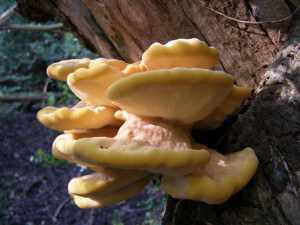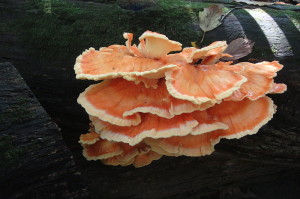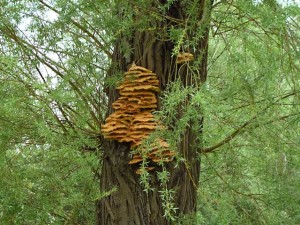
If you’re a beginner to fungus foraging, Chicken of the woods( Genus: Laetiporus) is a great fungus to seek out because it’s widespread in The United States and easy to distinguish from any look-a-likes as long as you know a few fundamental identification features. There are a number of species in the genus that all look very similar, and are all considered to be edible, a very common species is Laetiporus Sulphureus, which grows in the Northeast and feeds more on hard woods like oak rather than softwoods.
Edibility And Culinary Use
Younger brackets are edible cooked. As they get old they dry out and become inedible. This fungus’ claim to fame is its chicken-like fibrous texture. The taste is bland but can pick up other flavors that it’s cooked with. You can fry, bake or boil chicken of the woods, these cooking methods produce slightly different textures and give you some options for preparation. Here is a simple chicken of the woods recipe.
Health Benefits
Chicken of the woods has the ability to inhibit certain bacteria like staph bacteria(Staphylococcus aureus). It may also help prevent absorption of nutrients into cancerous cells.

Key ID Features
This fungus only grows on trees, either living or dead. Different species grow on different types of trees including hardwoods and softwoods, as well as different heights in the tree. This fungus is a type of polypore which means that it has pores(small holes) on the underside, instead of gills. The part that most people would call a mushroom is referred to as a bracket when it is a polypore growing from a tree and has no stalk. The top of the bracket is orange/yellow and grows in a shelf-like pattern, hence one common name, sulfur shelf Mushroom. There is typically a lighter colored margin at the edge of the bracket about 1/2″ thick(see photo). The underside is lighter than the top and can range from white to yellow. The pores of this species are very small and dense so you will have to look closely to see them. Once you have found the fungus, chances are it will be in the same spot for a few years before it dies. You can also install chicken of the woods spawn plugs in a hardwood log or stump and grow your own.
Cautions

There are some minor cautions with chicken of the woods. There have been rare reports of minor reactions in sensitive people including, swollen lips, nausea, vomiting, dizziness, and disorientation. These reactions may be due to a number of causes including, allergies to the fungus, individual reactions to the fungus’s proteins, toxins absorbed by woods such as eucalyptus or cedar, and eating old decaying brackets.
Conclusion
For expert and beginner fungus foragers alike Chicken of the Woods should be a staple wild edible. Its easy to identify, has no known deadly look-a-likes, and a texture that works well in many culinary dishes. This fungus is often perennial, so once you find it, you can return year after year to harvest.
Read our Article on: Safe Foraging
Many of our readers find that subscribing to Eat The Planet is the best way to make sure they don't miss any of our valuable information about wild edibles.
See our privacy policy for more information about ads on this site







3 Responses
Eating some right now. Love it. Found 15 lbs yesterday.
Awesome, they are such a great find for anyone interested in foraging.
Found some really fresh ones today, omg, bbq American style sause mixed in with egg for the batter. Fried chicked style. Its amazing!!! Dont tell any one.